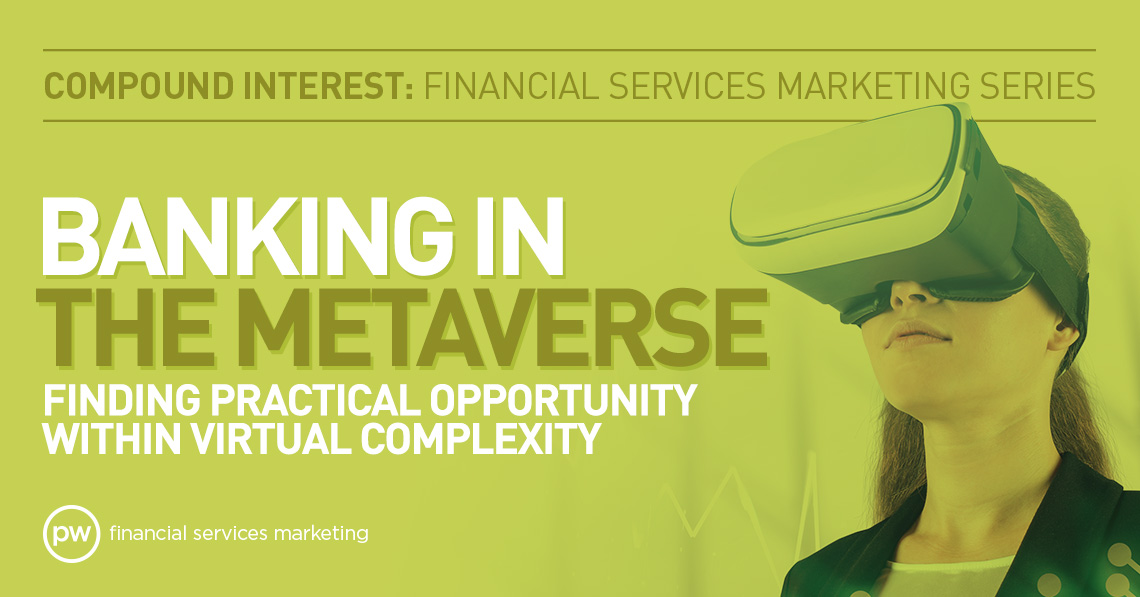Over the past year, the hype around the metaverse has accelerated at a dizzying pace. With all the talk, it was natural that speculation would run wild with what this means for various industries. In this article, we will look at what it means for the financial services industry. In today’s edition of Compound Interest, we will review what’s happening in the metaverse now and what might be to come, but we will also look at some of the more practical applications that banks and credit unions can build a strategy around sooner than later.
Despite the frequent media coverage around the metaverse, a January 2022 Ipsos survey says that only 28% of Americans felt like they could accurately define what the metaverse was. So if you feel like you need a refresher, don’t worry, because you’re in the majority, and PriceWeber published a non-industry-specific article in January that does a great job of defining what the metaverse is, what it could mean for brands, and how marketers should think about it.
Early speculation for financial services
If you’ve been following along with speculation about what the metaverse could mean for financial services, then you probably saw some early shots in the dark that were far out there. There was this vision of a person putting on their VR headset and having their avatar stroll into a virtual bank in the metaverse where they would receive personal service, maybe open a checking account, or even get some investment advice before strolling across the street to purchase a virtual macchiato for their avatar. But that’s not where the industry has gone so far. Another popular early notion was that it would be fintech firms that would dominate the space while traditional institutions took time to find their footing. This isn’t how things have played out so far, either. So, what exactly has happened with financial services in the virtual world?
A big bank with a big cat
It ended up being JPMorgan Chase that made headlines by being the first financial institution to open a physical structure in the metaverse when they created their Onyx Lounge in Decentraland (one of several virtual lands in the metaverse). However, don’t plan on visiting their location to open a savings account or make a credit card payment. The fifth-largest bank in the world instead decided that their role (at least for now) in the metaverse would be financing it. Instead of opening a virtual branch, the Onyx Lounge serves the purpose of, well … we’re not exactly sure. Named after the company’s blockchain-based Onyx platform, users can visit the lounge in the Metajuku mall to learn about all things crypto and blockchain. The premium location is just across from a clothing store where you can upgrade your avatar’s wardrobe. Below is a video recording of our visit to the lounge. Beware of the man-eating cat that’s prowling the grounds (we have no explanation for that).
https://vimeo.com/691373026
JPMorgan Chase also published a whitepaper that serves as a metaverse 101 course for potential investors. While it seems that their current strategy for the metaverse is lending to investors and developers, it’s unclear if the development of the Onyx Lounge was a mere token symbol of embrace for the metaverse, a playful way to experiment, or if they have big plans for the virtual property in the future.
Practical applications from the metaverse
It seems inevitable that the metaverse will bring with it a host of applications that might be beneficial for financial institutions outside of the cool cache of financing it or opening a tiger lounge petting zoo. It would be unreasonable to think that all the possibilities of the metaverse have been conceived at this point. If we were to look back at early notions of other technological advances that had undefined boundaries, such as the internet or social media, and compare that to what became a reality, we would discover many ill-conceived early notions. There’s little reason to believe the metaverse will be very different. We won’t get too far ahead of ourselves trying to imagine the distant future, but we will look at a few practical applications that financial institutions could take advantage of.
1. Virtual reality (VR)/augmented reality (AR) for virtual meetings
Whether it’s a virtual meeting between a financial advisor and their client or a mortgage loan officer attending a real estate closing virtually, there are multiple scenarios where virtual meetings could make sense for financial institutions. One development that will make this an easier bridge to traverse is essentially an evolution of a platform many financial institutions and their customers are already using today. Microsoft plans to launch a virtual meeting platform called Mesh in the first half of 2022. Mesh is positioned as a virtual reality version of the already popular Microsoft Teams platform and is planned to be integrated within Teams. This will allow Teams users to engage in a more immersive experience by connecting through any compatible device. This makes it a highly accessible option for institutions and their customers. If you’re already using Microsoft Teams for internal meetings, this will allow you to easily transition to Mesh and use internal meetings as a pilot phase before trying the technology with customers. You will be able to assess opportunities while giving your team time to get comfortable with the technology.
2. Trade, lend and hold cryptocurrency
Cryptocurrency is the financial backbone of the metaverse. While traditional banking institutions started off shunning cryptocurrency, now they’re looking for ways to benefit from it. To do this, an institution doesn’t have to double down with the sort of massive investment JPMorgan Chase made with Onyx. While they’re technically banks in their own right, digital asset trading platforms such as and Fireblocks can be valuable third-party partners for regional or local banks and credit unions looking to enter the cryptocurrency game. Such partnerships allow for expedited implementation of new capabilities by greatly reducing the legwork around development, compliance, and governance.
3. The next frontier of financial education
Making financial education more engaging is something banks and credit unions have struggled with for years. Many institutions are using proprietary or third-party provided applications for financial literacy education that are already meant to be immersive. Zogo Finance is a good example of a learning app many financial institutions have partnered with that gamifies financial education in the form of a mobile app. It even rewards users with a form of digital token that can be redeemed for gift cards. It’s easy to imagine this form of gamified learning which caters to younger audiences “leveling up” their knowledge while using VR or AR technology.
4. Faster, better training & onboarding
The previous point notes that using VR technology for education purposes with younger audience segments can help with engagement, but what about employee training and onboarding? There’s a data-driven argument for using VR for employee training that goes beyond allowing for remote training. PwC conducted a study in June of 2021 that looked at using VR for employee training of soft skills. They provided training to new managers in 12 markets, with some receiving the training through VR and the others receiving the same course in person in a classroom setting. The results were that the new managers who used VR tech to take the course learned the material four times faster than the in-person trainees and reported being 275% more confident in applying the skills they learned than their in-person counterparts.
So, what now?
One of our biggest takeaways from evaluating opportunities in the metaverse is that there are many avenues to choose from that come in all shapes and sizes. Every organization will need to evaluate their opportunities with what they know about their customer base to develop a purposeful strategy, but the fact is that while the metaverse may sound like a scary black hole that one must either plunge into or not, there are plenty of practical opportunities to dip your toe in.
Virtual real estate in the metaverse has recently garnered a lot of headlines due to rapidly rising values. It’s worth noting that none of the four practical applications listed above would require ownership of real estate in a virtual land. There are ways to implement each one of those applications with or without virtual property.
Another key consideration when crafting your strategy is to account for what percentage of your audience has access to a VR headset. According to a poll conducted by Morning Brew last summer, almost a quarter of Americans have used a VR or AR headset, but only 31% of those same people owned a device. Some applications will require access to VR / AR devices, while others will be enhanced by such devices. This is an important consideration when mapping out a strategy for your audience.
We’ve highlighted several examples in this article, but there should be countless opportunities for financial institutions to leverage technology related to the metaverse without developing something proprietary, investing in expensive virtual land, or having an extremely techy customer base that owns the latest VR gear. However, leveraging these technologies in a secure manner that adds value for customers and is beneficial for the institution will require vision, strategy, knowledge of your audience, and a technical understanding of how these technologies and applications will connect with each other. In other words, getting this right doesn’t mean just dumping it on the plate of the Chief Technology Officer. If you were building a new website today, you would involve individuals from business intelligence, customer experience, stakeholders from individual business lines, marketing, and so on. You should think of evaluating opportunities in the metaverse the same way. Find the right mix of internal perspectives and external in the form of an agency to help consult.
While the metaverse might sound like a scary new world for financial institutions, the reality is that it’s essentially just the next evolution of your current customer experience.
Here when you need us.
If you need a hand working through what your institution’s future looks like on the metaverse (or if it should even be there!), give us a call at 502-499-4209 or drop us a note, and we’ll be happy to chat in the real world or the virtual one!


